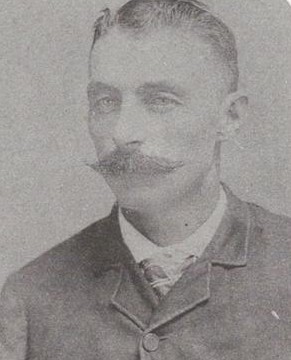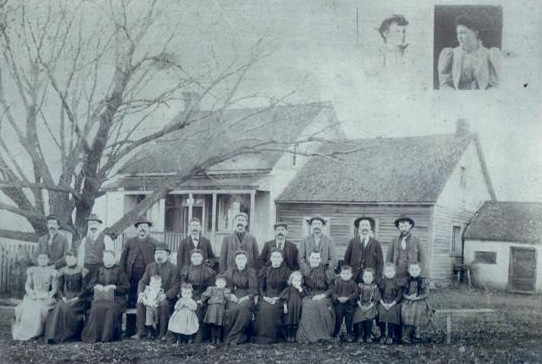This article presents Thomas Lane, an influential figure who contributed to the development of Rawdon from the earliest years of the township and who will have left many descendants still living in the community.
Let’s first look at how he was presented by the newspaper L’Action populaire on April 17, 1924:
[Translation] “The first Catholic to settle in Rawdon did so around 1824. Ths Lane—that was his name—was an interesting individual. This figure was endowed with qualities and titles that very few suspect. Ths Lane was a native of Dublin, thus Irish, a graduate from the university of the same name, a distinguished linguist, speaking at least eight languages: Gaelic, English, French, Latin, Italian, Spanish, Greek, German…and, above all, a committed and fervent Catholic, who had to fight hard against Lord Rawdon and his protégés, and who fought so well that, to his credit, he was dubbed ‘The Pope Lane.’
“It was he who chopped down the first tree to build the primitive church, around 1828.”
This text was reproduced verbatim in the souvenir album of the pastoral silver jubilee of the Reverend J.-M. Landry, parish priest of Rawdon, dated May 8, 1924.
Data from the first census of the population of the township of Rawdon, conducted in 1825 by Philémon Dugas, show that Thomas Lane was already established in Rawdon. He had settled there with his wife, Margaret Wood, and his first son, John.

He settles on lot 25 of range 3
Marcel Fournier, in his book Rawdon : 175 ans d'histoire transcribed and edited the data from this first census and a statistical survey on property titles carried out in 1824. This transcription identifies Thomas Lane as a resident on lot 25 south of range 3. The information added by Marcel Fournier concerning the property titles reveals that Thomas Lane did not hold any formal legal titles at the time of the statistical survey, since the location ticket was only issued on March 28, 1826. The letters patent were issued on July 5, 1831, some five years later, as evidenced by this compilation of the list of concessions.

A higher education
The article from the newspaper L’Action populaire also highlighted that Thomas Lane had received a higher education in Dublin before emigrating to Canada. Internet researches identified two institutions offering university education programmes in Ireland at the time: Trinity College Dublin and St. Patrick's National Seminary Maynooth. These researches also revealed that in 1794, Trinity College Dublin, a Protestant institution, accepted Catholic students. If Thomas Lane was accepted, such an event would be a unique achievement for future Rawdon residents. Reverend J. E. Burton of the Church of England (lots 13, 14 and 15 of range 1) was a graduate of Trinity College, and the family of William Tighe (lot 26 of range 10), a teacher, believed that he was, as well. It seems more likely that Thomas Lane studied at the Maynooth Seminary. The Maynooth Seminary was founded in 1795 for the education of Catholic priests. Its curriculum at the time had a French-speaking flavour, as it was taught by priests who had fled the French Revolution. There is every reason to believe that this programme must have resembled that of Quebec seminaries, which would explain the knowledge of several languages, including Latin and Greek. With men of such stature as leaders from the very beginning, there is no doubt that children’s education held a prominent place in the community.

A prominent figure in community life
A prominent figure among the families who contributed to the creation of Rawdon, Thomas Lane actively participated in the establishment of the Catholic Church in Rawdon. The note mentioning that he had to fight hard against Lord Rawdon and his protégés was likely meant in the figurative sense. An article in the newspaper The Vindicator and Canadian Advertiser dated January 13, 1835, reported a series of events that took place in Rawdon starting on December 6, 1834. Following a meeting held at the Anglican church rectory, resolutions were adopted to build a school and change the name of the village. In response to these resolutions, Thomas Lane and a group of citizens opposed them and adopted seven resolutions demonstrating the spirit of collaboration that reigned between Protestants and Catholics. The first resolution stipulated that Rawdon’s public schools should not be controlled by any stranger having drawn a line dividing the Protestant and Catholic residents of this township and sowing discord between them. Out of the seven resolutions adopted at that meeting, Thomas Lane proposed three and seconded two. The others who contributed to the adoption of these resolutions included Lieutenant Colonel Thomas Griffith, Major Robert Bagnall, Edward McGie, Edward Corcoran, John Carroll, Patrick O’Neal and John Woods.
In his book Up to RawdonIn his book Up to Rawdon, Daniel Parkinson relates another event representing a fine example of the good will and tolerance that existed between Protestants and Catholics in Rawdon. Following what Daniel suspects was a typhus or scarlet fever epidemic and the quarantining of the Burns family, three young daughters of John Burns died between December 12 and 23, 1872. Neighbours of the Burns who lived on lot 21 of range 3, the Lanes (John and Thomas, son) brought the three girls’ bodies to the Methodist cemetery and had them buried by the pastor.
An article from the book Up to Rawdon (pages 1087 to 1112) entitled “And the Boys are at the Barracks” identifies the principal members of the Rawdon militia. Citing the Répertoire des officiers de milice du Bas-Canada, 1830-1848 by Denis Racine and the Société généalogique du Québec (1986) as a source, this article indicates the different ranks obtained by Thomas Lane over the years. He was first an ensign as of 1836, became a lieutenant in 1846, and was then captain from 1856 to 1862.
Thomas Lane’s progeny
Thomas Lane and his wife Margaret Wood (1807-1890) had no fewer than six children, including four boys and two girls. A document provided by the family indicated eight children. At the time of the 1851 census, Thomas Lane was 56 years old, and his wife was 44. This same 1851 census identified the following children: John (27 years old), Mary (24 years old), Catherine (22 years old), Thomas (16 years old), Edward (14 years old) and James (10 years old), as shown in the excerpt below:

At the time of the 1861 census, Thomas Lane and Margaret Wood were still living with Catherine, Thomas, Edward and James. Their eldest daughter Mary (1825-1915) had joined the Sisters of St. Anne. Known as Sister Marie-de-la-Conception, she worked in Western Canada. Their eldest son John (1824-1908) had married Catherine Price, the daughter of Thomas Price and Briget McGrath, in Rawdon on February 10, 1852. Catherine, mistakenly identified as Prince in Marcel Fournier’s book, was in fact named Price, as specified in the book Up to Rawdon. The name Price is confirmed by the compilation of the list of concessions available in the Registry of the Surveyor General of Quebec. Thomas Price, Catherine’s father, had obtained the letters patent for lot 25 south of range 8 on October 24, 1831. At the time of the 1861 and 1871 censuses, John Lane and his wife Catherine Price had at least ten children (Margaret, Thomas, John, William, James, Edward, Mary, Catherine, Ambroise and Charles). A document provided by William’s family indicated nine children.


Thomas Lane passed away on February 18, 1864, at age 72, and was buried on February 20 in Rawdon’s Catholic cemetery. In his will, drawn up on December 15, 1863, and available in the acts (no. 966) of the notary John Horan, he left his properties to his sons Thomas, Edward and James. These properties included lot 25 of range 3 and the southwest half of lot 24 of range 2. He gave Thomas the use of the farm, known under the name of McDermott, along with the 50 adjoining acres. He left James the 50 acres that included all the buildings, with the obligation to provide housing and a means of transportation to his mother and his sister Catherine, who also received a financial allowance. As for his daughter Mary, who had entered a religious community, he felt that she had received fair compensation through the education that she had received. Lastly, for John, whom he had named executor, he deemed that he would be amply compensated by any share that he might receive from his inheritance. An act (no. 85) of the notary Horan signed on August 4, 1852, indicates that Thomas Lane and his wife had already given John his inheritance while they were alive.
His wife Margaret Wood survived him by many years. She died on June 19, 1890, at the age of 90. She was also buried in Rawdon’s Catholic cemetery. Several of Thomas Lane’s and Margaret Wood’s many descendants still live in Rawdon.
Sources
- Censuses of Lower Canada, the Canadas and Canada (1825, 1851, 1861 and 1871)
- Register of baptisms, marriages and deaths – Saint Patrick’s Parish in Rawdon
- Compilation of the list of concessions – Registry of the Surveyor General of Quebec
- Rawdon : 175 ans d’histoire / Marcel Fournier, Joliette, 1974
- Up to Rawdon: Settlers at Rawdon Township, Lower Canada, C. 1820-1852: Their Origins and Continued Migration Across Canada and the United States, Volume 1 & 2 / Daniel Parkinson, 2013, 1156 pages
- Sur la route des souvenirs : gens du chemin Kildare et des environs, collective, 2014
- “Historique de Rawdon” [History of Rawdon], L’Action populaire, April 17, 1924, page 2 – available at BAnQ https://numerique.banq.qc.ca/patrimoine/details/52327/2577399
- Oral tradition and documentation from representatives of the Lane family
Comments:
Without diminishing Thomas Lane's importance to the community, certain statements in the article from the newspaper L'Action populaire dated April 17, 1924 deserve some historical clarification. The first individuals to settle in the Township of Rawdon are said to have settled there around 1816. In the 1824 census, there were 475 settlers. Of this number, it might be possible to show that at least half were Catholics. In a similar way, the fight against Lord Rawdon would not refer to an armed struggle but must be interpreted in the sense of defending the Catholic faith.
Thanks to the members of the Lane family who contributed to this article.
